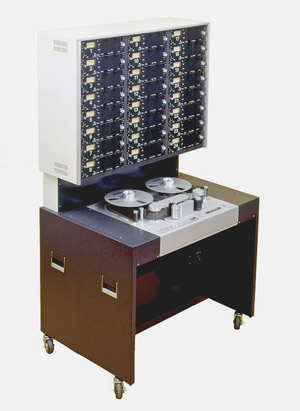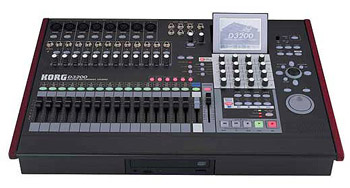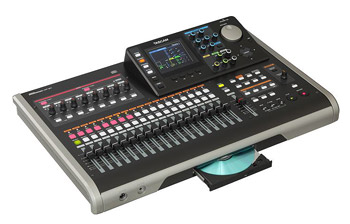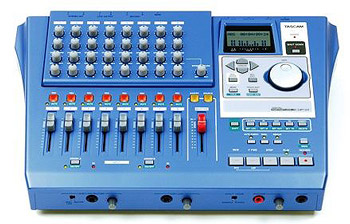RECORDING the Hammond Organ
North Suburban HAMMOND ORGAN Service
The first picture shows a multi-track tape recorder. As you can see, it is a lot bigger than a normal tape deck. In fact the entire machine is on wheels. The tape transport is in the lower half, and above the tape deck are the individual electronics modules for each of the twenty-four tracks that this machine can use. Tape speed in these machines is usually a lot faster than that of more conventional tape recorders, with many operating at a rate of 30 inches per second. At that speed, a 10 inch diameter reel of two inch wide tape will allow just 15 minutes’ of recording time. These special large reels of tape today can cost up to $300 each, so that for enough tape to record an hour’s worth of material, you will spend around $1200 bucks.
The multi-track tape machines such as this picture shows are no longer in production as far as I know, but late model used ones are still available. The picture is of a Studer brand machine for sale on eBay and the asking price was, when I checked, $25,000. So obviously, multi-track tape recording is out of the question for most of us. Generally, only high-end commercial recording studios have and use this equipment today.

Figure 4. Studer 24 track recorder, a very popular machine still used in some commercial recording studios. The twenty-four individual track recording amplifiers are in the top section, above the tape deck. These machines are big and fairly heavy as evidenced by the four wheels on the bottom.
The following pictures show several digital multi-track machines. As you can see, they are a lot smaller, easily portable, and they also generally do a better job. They also contain complete mixers to make the combining of the individual tracks into a mixdown very easy, and some of them also include a DSP as part of the package.
It is interesting to note that the specifications for a high-end tape machine state that the useful frequency range for recording is from 30 Hz to 15kHz. Yet for a tiny fraction of that price, the digital multi-tracker has a wider range, from 20 Hz to 20 kHz. This, by the way is considered to be the standard audio frequency range, comprising all frequencies that people whose hearing is good can hear and recognize. This is also the standard frequency range for audio CDs.

Figure 5. A digital multi-track recorder capable of recording a total of 32 tracks, and 12 tracks simultaneously.
Figure 6. Another digital Multi-track machine, with 24 total track capability, and can record eight separate tracks simultaneously. Notice also that it contains a CD burner for making a master CD after the mixdown is completed.

Tape recording still has its advocates, who claim that the sound quality of a recording made on tape is “warmer” than that made with digital recording. However, my question is, “what does warmer mean in reference to recording?” Unfortunately, when it comes to describing sounds, our superbly versatile English language must resort to vague terms whose primary meanings refer to subjects other than sound or music. OK, enough semantics. Back to the subject at hand!
The fact that most recording today, whether amateur or professional, is done on digital equipment pretty much attests to the general superiority of that method; superior both in frequency range, lower equipment cost, and greater ease of subsequent editing and mixing.
Figures five, six and seven show how much smaller the digital multi-track machines are. Also, the cost of these units is around $1000 or less, making them affordable to a wider group of users. These machines also have extra tracks. Although you can't record on all the tracks simultaneously, you can record at least eight or twelve tracks at once, and then you can store these in the machine and record more tracks. When the entire recording process is completed, you have individual playback control over all 32 or 24 tracks, and using the on-board controls, you can combine them into to a standard two-track or channel stereo mixdown.
Figure seven shows an interesting specific type of multi track recorder. On this machine, you can record any two, but only a maximum of two, tracks simultaneously, and you can do this repeatedly until you've used all eight tracks. However, after you’re done, by means of the mixing controls, you can combine them as you see fit to produce a final standard two channel stereo recording for distribution. A machine such as this is ideal if you only intend to record a Hammond organ, and/or only record your own playing, inasmuch as when you do that, most of the time you only need two tracks at once. On rare occasions when you need to record more than two tracks, or, if you are using a multi-channel instrument such as a Hammond X66, then it’s possible to combine a number of different channels in a mixer, and use this type of machine to record the resulting mix. This machine, however, will let you combine tracks together so that you can indeed record the equivalent of more than eight tracks. Lot less expensive than a true multi-tracker that lets you record on more than two tracks simultaneously!
Figure 7. An eight-track multi-track machine on which you can only record two tracks at one time, but once you’ve recorded the two tracks, you may continue to add more tracks. You can also combine a number of tracks into either a single track or a pair of tracks. This lets you record in a sense, more than eight tracks, so it is possible for one person to create very complex multi-track arrangements that seemingly exceed eight tracks, although during the final mixdown, combinations of multiple tracks are treated as either a single track or a single pair of tracks when using this method.

In much of today’s recording, artists will frequently record a certain number of tracks on a multi-track machine. Then they can listen to these, and perhaps add yet more tracks, by playing along with what they already recorded. Or, if they are not happy with a particular track, they can re-record just that one track while listening to the others. Frequently artists, such as singers, will record a vocal track, and then while listening to it, they will sing harmony to their first track while recording the additional track with the harmony. Meanwhile, it’s possible that the drummer recorded a few tracks first to establish the rhythm for the song, and perhaps either the vocalist or other instrument-playing musicians will have added their parts as well.
One useful technique that can be done using any of these multi-track machines is to start by recording a simple guidance track, which might be just a single one-finger version of the melody played on a keyboard. Then using the guidance track you can add rhythm and bass and accompaniment tracks and then add solo instruments. When that is done, you can ignore the guidance track, or even record over it as it's no longer needed. But if you are hand-playing the rhythm track, it is nice to hear the melody via the guidance track so that you can add the necessary fill-ins and variations in the appropriate places.
These digital multi-track machines also include metronomes so that you can maintain an accurate tempo, and the nice thing is that the metronome does not typically get recorded so your completed mix will not have the regular metronome ticking included. By using both the guidance track and the built-in metronome, you can know exactly where to add different instruments, rhythms, accents and other effects precisely where they should be in the final result. Is is generally good practice in much typical recording to have an accurate drum or rhythm track recorded early on, as then it is easy to follow as you add other parts.
If you are also using a keyboard with a built-in drum machine, or a separate drum machine, via a MIDI connection, you can synchronize the tempos exactly so that the rhythm runs in exact synchronism with the metronome in the recorder.
Back to Page 3. Page 4. Go to Page 5.